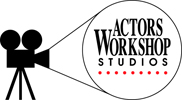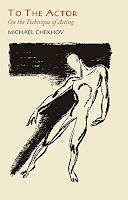Hello all.
OK, elephant in the room first. For various reasons, I had to leave class early last night, and the illustrious Robert Dey took the reigns (thank you, Rob).
We began class with a discussion on the business side of acting, as far as the pros and cons of joining SAG, moving to LA, getting an agent, and other related issues. Lots of intelligent questions, resulting in a good conversation. We also left you with instructions to bring your headshots and resumes for review next week.
We began work on reviewing Chekhov and the first 9 exercises from his book To The Actor, which, unfortunately, devolved rather quickly, due to the fact that “Teacher.EXE” stopped functioning…
I stayed long enough to see monologues from Niko and Carlo, which were very enjoyable. Where it went from there, sadly, I know not.
However, regardless of the way the rest of the class played out (well, I hope), I decided to come here onto the blog and lay out the rest of what I’d hoped to cover.
——————————-
The stress of the night’s work was going to be on the physical aspect of the acting, with Chekhov’s technique as it’s base. Chekhov stressed the direct connection between the human body and psychology, as far as how they are constantly at interplay in our day-to-day lives. There seems to be a disconnect when it comes to acting between the body and what motivates it’s actions. An actor can feel roles deeply, but be unable to effectively express/convey that to the audience.
The Body: Your body needs to be trained – beyond merely gymnastics, dancing, fencing, etc. You need to train it to respond to your psychological impulses properly. It isn’t enough to rely on instinct or mechanical operation.
The Psychology: Training your psychology goes beyond merely understanding and using your own natural inner drives. Chekhov strongly suggests studying the psychologies of people from history, of characters from other plays from earlier eras, of peoples from other modern cultures, and even the psychologies of people in your current life, whom you know, and especially those you don’t particularly like. Try to get inside their heads, understand what makes them tick, why they may think and act the way that they do. If you can do this without criticism or judgment, that’s huge.
If you can understand someone else’s psychology, then when you craft a character who is different from you, you can give him/her a proper mindset, which your body will (hopefully) respond to in a way that makes sense for that character.
Let me stop here and insert a video or two…
Here is another clip from Michael Chekhov himself, from the 1945 Alfred Hitchcock film Spellbound. It is a scene between Chekhov’s character Dr. Brulov, and the great Ingrid Bergman. As you watch it, compare their acting styles…
Bergman is no slouch, but her acting approach is traditional, stoic, mechanical, theatrical, melodramatic and – compared to Chekhov – lifeless. Whereas Chekhov’s performance is alive, bursting with nuance, from the top of his head to the tips of his fingers… and he’s mostly just sitting there, in that chair!
This shows how in command he is/was of his body, and it’s connection to what’s motivating him inside. Bergman looks stiff, almost uncomfortable in her own skin. Like she’s acting! Even the hug at the end shows stark contrast. To me, anyway.
Here’s another clip, from Game of Thrones – it’s a clip I showed in an earlier class, between Daenerys and Tyrion, as they (also) sit and talk. Watch Emilia Clark‘s stoic, stiff, near-expressionless performance (which some will argue fits her queenly character in that moment), and Peter Dinklage‘s performance during the conversation. Not just his face but every shift of his body, every swirling of his wine cup. Watch how his emotional, psychological journey is directly reflected in his body, whereas with Clarke, we don’t really see the connection – as though she’s hiding – perhaps by choice.
Of course, they had excellent writing to perform, but still, the nuance in Dinklage’s face and body… top notch.
There are 9 “Exercises” which Chekov begins with, which are well worth studying in detail. I highly recommend ponying up the $2.99 for the Kindle version of To The Actor. Well worth 3 bucks, I assure you. But until then, here is a summary of the exercises, which I hope to try at some point with you all in class.
EXERCISE 1: A series of broad, wide, simple movements. Involve and utilize entire body. OPEN yourself up completely, spreading arms/hands and legs far apart. Remain expanded for a few moments. Imagine becoming larger and larger. Come back to rest. Repeat several times. CLOSE yourself by crossing arms, hands on shoulders, kneel, head low. Become smaller and smaller, feeling like disappearing into yourself. THRUST forward one step, arms stretching out. Return. Go back, and sides. Do a SMASH motion, like a blacksmith beating an anvil. THROW something in different directions. LIFT something and HOLD it over your head. DRAG, PUSH, TOSS. Avoid dancing movements. Don’t hold your breath. Don’t hurry.
EXERCISE 2: Center: Imagine that within your chest is the center from which all activity stems. It flows out of your limbs, and energizes your actions. Every limb starts at your chest. Perform actions, such as taking off a shoe and putting it back on, or your jacket. Walk, sit down, stand up, lie down flat. Purposely instigate the actions from your chest. Do it again while sending the energy out first, ahead of the body, again, initiating from your imaginary center. This makes the movements purposeful and more visually engaging.
EXERCISE 3: Molding the Air Around You: Tell yourself that your movements are sculpting the air around you into forms, chiseled into the air around you. “Now I begin my movement, which creates a form; Now I finish it. The form is there.” Think of and feel your body to be a movable form. Imagine that the air around you resists your movements. Repeat the movements, like an artist practicing drawing the same line. Try to mold the air using single body parts, instead of just the whole body, all the way down to individual fingers (hands and fingers can be the actor’s most expressive assets). Shift out of simple movements, and again trying to activities (shoes, jacket, etc) at an easy, lifelike tempo, but try to retain the feeling of forming, and the air resisting, remembering your center. When coming into contact with objects, pour your power into them. Spend your power lavishly – it’s inexhaustible. “Every movement I make is a little piece of art.”
EXERCISE 4: Floating. Again, big, simple movements. “My movements are floating in space, merging gently and beautifully one into another.” Avoid unnecessary muscle tension, but don’t let the movements become weak or vague. Imagine the air around you is water, and that your movements are skimming over the surface of the water.
EXERCISE 5: Flying: Big, simple movements. Imagine your body is flying through space, movements merging seamlessly into one another. As your physical movements pause/stop, inside you’re still embracing the feeling of flying. Start with big simple movements, segue into natural movements, and then walk/activity. Keep the sensation of lightness, ease, flying, soaring inside.
EXERCISE 6: Radiating: Begin with big, simple movements, but now send your power/energy out in the direction of the movements. Lift your arm, lower it; walk around the room, sit down, stand up. If (for example) you sit down and your body stops, psychologically you continue to radiate that you are sitting. This manifests by the reality of you enjoying the relaxation that accompanies sitting. Radiate this energy around you – not just in the same direction as the movement, but fill the space around you with energy that radiates from your center. Imagine that the air around you is filled with light, coming from you.
EXERCISE 7: Imagination Only: Try to repeat the sensations of molding, floating, flying and radiating with imagination only, as you sit/stand, motionless.
EASE/FORM: Heavy movements and inflexible speech are counter-creative. Themes can be heavy – but the technique may not. Always retain the distinction between “what you act” and “how you act it.” You are not the character – you are the artist portraying the character. The character may be heavy – the performing of the character cannot be.
EXERCISE 8: Beauty: Think of something that you find to be beautiful. Ask yourself why you find it beautiful. Form? Harmony? Sincerity? Simplicity? Color? Moral value? etc. Think of other things, ask the same questions. Refine and strengthen your ability to detect beauty around you. Once you identify beauty, to try infuse the previous movement exercises with a sense of beauty, performing the movements beautifully.
ENTIRETY: Don’t view your performance as a collection of individual moments, movements, and lines. This would encourage a disjointed performance, in the whole. Keep in mind the entirety of the performance, the details. This will train you to view the performance as a whole, and each moment a stroke of paint on the canvas. You will keep in mind the essentials of your character, and keep an unbroken main through-line.
EXERCISE 9: Entirety: Review the events of your day today. Pick out periods which are complete in themselves, as a scene in a story. Define the beginning and end. Review the details again and again in your memory until each “scene” stands out as an entity, and also coheres to the other scenes, to form a narrative of the day. Entirety! Try doing it for longer periods in your life. Then craft a future to continue your story! Do the same for historical people. Do the same for objects, looking at them as entire forms – and then as separate parts which can stand alone as “scenes” contributing to the whole. Imagine each piece put into a frame, like a series of paintings on a wall. Try the same with a song, listening to the song as a whole, and then trying to separate out the individual instruments. What does each piece contribute to the overall theme? Now divide the room you are in in half – one part is the stage, the other is off-stage. Enter the stage, say a couple of lines of dialog, then exit to the “off stage”. Get a feeling for “appearing” on stage, and “disappearing” off stage. Grasp the entirety of the process, then look at the individual pieces.
To radiate on stage means to give and to receive. You are constantly doing one or the other – you’re never idle. Receive the presence of the other actors, receive their actions and words, receive the atmosphere that is on stage, receive the surroundings, receive the events. Never passive. Receiving means to feel drawn toward or into the energy/power of the things, people or events.
——————————–
In the book, Chekhov goes into more detail on these exercises (and far more, of course). Again, it is well worth the $3 to buy the Kindle version.
In discussing the Psycho-Physical approach to acting, I was going to discuss the art of Sports Entertainment – a.k.a. Professional Wrestling. Don’t scoff! Acting doesn’t get more physical than that! There’s no avenue of story-telling quite like professional wrestling. Before you dismiss it as “fake” or “for kids”, I think it’s worth taking a deeper look. Which we will do, next class and/or blog post. I think I’ve maxed out the word count on this blog post…
Hopefully, I’ll be back in form by next class.
Dave Wagner
AWS Staff


